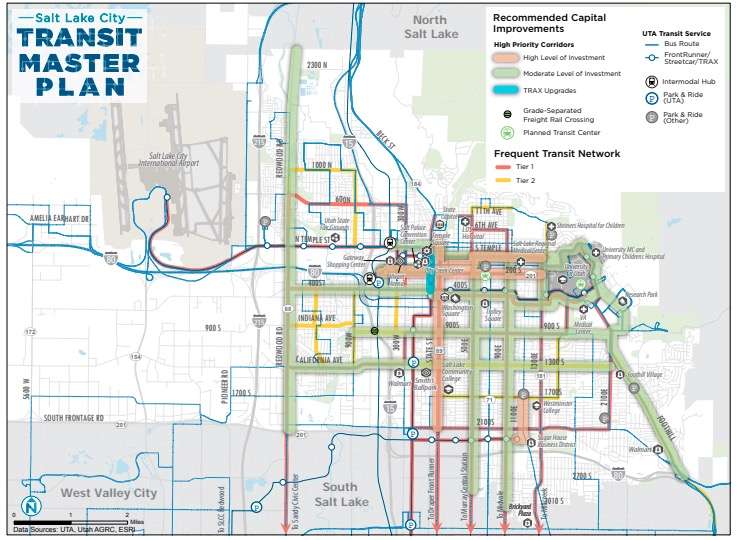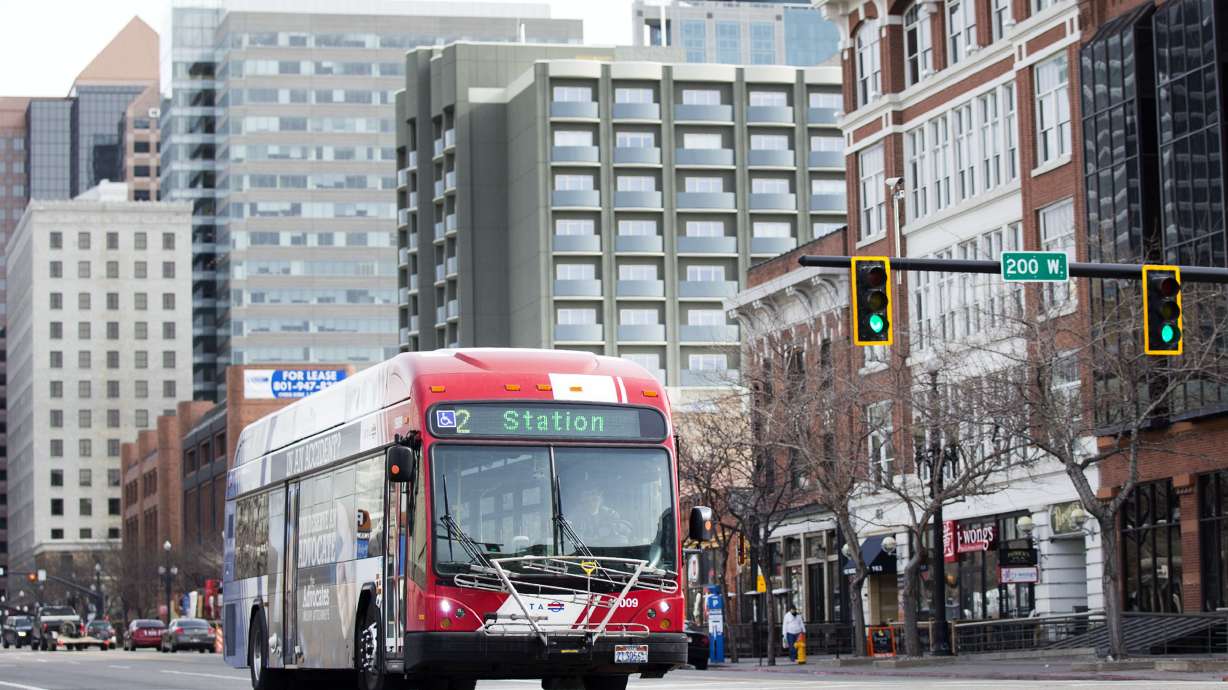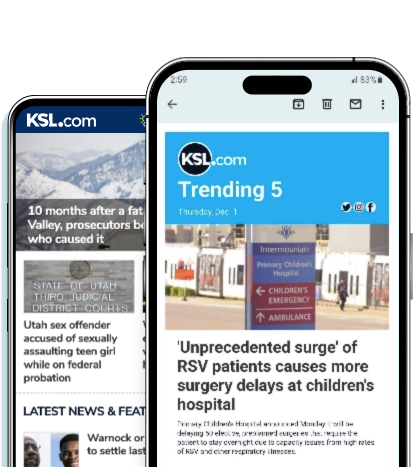Estimated read time: 8-9 minutes
This archived news story is available only for your personal, non-commercial use. Information in the story may be outdated or superseded by additional information. Reading or replaying the story in its archived form does not constitute a republication of the story.
SALT LAKE CITY — When the next Utah Transit Authority schedule “change day” occurs Sunday, riders who use three bus routes that go from east to west in Salt Lake City will soon see more frequent busses and a schedule that goes further into a day.
It’s the first installment of the city’s recent plan to improve mass transit options connecting underserved portions of its community, and it's part of a slew of changes UTA officials hope will improve transit connections among five counties in the state.
The largest of the changes will be in Salt Lake City from the partnership between the city and UTA, which officials said is the first of its kind in the state. Essentially, UTA pays for the standard service and Salt Lake City will pay for the extra bus times that UTA provides.
This Sunday, UTA will extend service for routes 2, 9 and 21 specifically under this agreement with the city. Here's a breakdown of what those routes will be:
- Route 2 connects the University of Utah Medical Center to Salt Lake Central Station and includes portions of the university’s campus and 200 South downtown.
- Route 21 connects from the central portion of the U. campus to the Central Pointe TRAX station with a route through Sugar House. Not much will be adjusted to those routes.
- Route 9, which currently connects the medical center with Central Pointe Station with a route that cuts through 900 South before reaching Central Pointe Station, will now service the city’s Glendale and Poplar Grove neighbors by using California Avenue, Navajo Street and 400 South, where UTA’s Route 516 once ran through. Route 516 is to be discontinued.
"That's expanded hours, expanded days of service, additional weekend service and additional early morning and late-night service, so it'll come more often and run earlier and later and on weekends," Eric Callison, manager of service planning for UTA, told KSL.com. "It's a pretty large service improvement for those routes."
The extra bus service was thought up during Salt Lake City's Transit Master Plan, which was adopted in 2017 and funded as a part of a 0.5% city sales tax increase approved by the City Council and Salt Lake City Mayor Jackie Biskupski in 2018, said Salt Lake City transportation director Jon Larsen.

The agreement essentially runs for 20 years with the City Council having to recommit to funding each year because the council can't commit to future funds, Larsen explained. It differs from how funding usually works, which comes from county sources.
“It’s something that’s been years in the making and really has come together nicely in the last couple of years,” he said. "We worked closely with UTA to actually pay them to run additional bus service in Salt Lake City."
Once the city adopted the plan, the two sides worked together to form an interlocal agreement and will have that agreement begin Sunday.
As Larsen pointed out, it takes time to get additional busses, operators, mechanics and all sorts of personnel and figure out the bus stops and routes, as well as end-of-line facilities — which included coordination with the University of Utah, where several routes do end in the city. That was all completed in about 1 1/2 years. To put in comparison, both city and UTA officials said it has taken other cities in the country upward of five to seven years from agreement to completion with transportation agencies.
During the planning process, city and UTA officials collaborated to identify a grid where places were underserviced in Salt Lake City, where they quickly identified connections between the eastern and western portions of the city. That’s why the city circled bus routes 2, 9 and 21.
It'll add some access to people on the west side of the side who, historically, haven't had as much access to public transportation.
–Eric Callison, manager of service planning for Utah Transit Authority
They wanted to improve the schedules because only Route 21 runs past 8 p.m. among the three current schedules. Under the incoming changes, all three routes will have service until midnight on weekdays and Saturdays, and service every 30 minutes on Sundays.
The change benefits those in Salt Lake City's Glendale and Poplar Grove neighborhoods, who will have better access to public transportation throughout the day. That includes students who can go to more extracurricular activities without worrying about missing a bus home, city officials said.
"It'll add some access to people on the west side of the side who, historically, haven't had as much access to public transportation," Callison added.
City officials also hope more access will help reduce carbon emissions and reduce the need for a car to be involved in the city's economy.
The extra bus routes are actually just the first step in the partnership between the city and UTA. The city hopes to include additional service to the Rose Park neighborhood within the next few years in the area of 600 North and 1000 North, as well as routes on 400 South to round out the first phase of the plan.
There's also a plan for microtransit options in the future for parts of Rose Park, the Avenues and the city's east bench. That plan currently calls for a no-cost transportation system that would take people in those areas to their nearest transit station, Larsen said.
"Basically what that is is on-demand ride service," he said. "It's an innovative pilot that we're doing that is actually city-led but partnering with UTA that would help make transit more accessible for people in the edges of the city where running a 40-foot bus just isn't really a very realistic solution. ... We're just getting started. We're going to continue to work to make it a more healthy, livable, sustainable city."
As for UTA, there might be similar agreements with other cities in the future. Callison said other cities have started talks with to expand service in their communities after the agreement with Salt Lake City was finalized.
He didn't specify which cities those were but said they had asked about starting transit master plans.
"We're hopeful; we're excited that that kind of process could become more of the paradigm in the future," Callison said.
Other major UTA changes
Another Salt Lake City change will be near the University of Utah Hospital. In an effort to reduce traffic outside the hospital and make it easier for ambulances to reach the hospital, UTA agreed to pull service out of the hospital loop, Callison said. A few buses at the U. will be moved to other locations on the U. campus near the hospital.
Larsen said there is a plan in place for a new UTA hub on campus in the works.
In addition to the agreement with Salt Lake City, monies made available from Proposition 1 in 2015 will allow new and better UTA service in Tooele and Weber counties, according to Callison. Those changes include more busses to Grantsville and Tooele, as well as trolley bus in Ogden, and service to West Haven for the first time.
There are more routes meant to reduce traffic jams in the Lehi tech corridor and plans to better connect Utah and Salt Lake counties.
Starting Aug. 12, @RideUTA will have two brand new bus routes available, with stops right at several companies along the Tech Corridor & at the Trax/FrontRunner station. Check out the new routes and try transit next week. https://t.co/j4iFBZmQegpic.twitter.com/4MbJVMtBnT
— I-15 Technology Corridor (@i15techcorridor) August 7, 2019
UTA also plans to discontinue routes 228, 453 and 500 in Salt Lake County, as well as 811 and 863 in Utah County, and F401 in Tooele County. All of those will be merged into either other existing or new routes.
"(There are) a lot of changes, but it's very positive for our riders and the communities that we serve," Callison said. "It's been a lot of work, but it's also been kind of a feel-good change day as well because we've been able to add so many transit options in our system."
New routes:
- Route 4 will take portions of the 228 and 516 routes. The route will connect Poplar Grove in Salt Lake City to Olympus Cove in Millcreek using 400 South and Foothill Drive, going through downtown Salt Lake City and some of the University of Utah campus.
- Route 601 is a trolley car that connects Ogden Station to downtown Ogden using 25th Street. It will be a replica trolley much like similar UTA trolley routes in Davis County.
- Route 871 is a route that connects Draper Town Center TRAX station and the Lehi FrontRunner station. It will run every 30 minutes on weekdays and every 60 minutes on weekends.
- Route F453 connects the 2400 North Park & Ride in Tooele to the 1940 West TRAX station on North Temple in Salt Lake City.
- Route F620 connects Roy and Ogden Frontrunner stations via Midland Drive in West Haven.
Other big route changes:
- Route 200 will replace Route 500 as the bus that stops at the Utah State Capitol (on weekdays only). The route will also start/stop at North Temple Station instead of Salt Lake Central Station.
- UTA has shifted bus Route 223, which connects the Union Building at the U. with the Cottonwood Corporate Center in Cottonwood Heights, to serve Research Park and the University Medical Center TRAX at the U. campus. UTA also plans to have a bus on the route every 30 minutes during weekday rush hours and every hour during mid-day and early evening hours.
- Route 454 will now have five trips each day instead of one. The route connects Salt Lake City and Grantsville.
- Route 551, which connects the Power TRAX station on North Temple and portions of Salt Lake City’s northwest quadrant west of Salt Lake City International Airport, will no longer include a loop around the airport. However, it will have a few more weekday routes and will run on Saturdays for the first time.
- Route 850, which connects Lehi and Provo FrontRunner stations, will now run every 60 minutes on Sundays. It will also have a connection with the 871 bus route, which will help connect bus service between Utah and Salt Lake counties on all days of the week.
- Route 864 takes the place of outgoing Route 863. The route starts and ends at the Lehi FrontRunner station and reaches places like Xactware, Mountain Point Medical Center and Thanksgiving Point. The new schedule includes mid-day service times.









